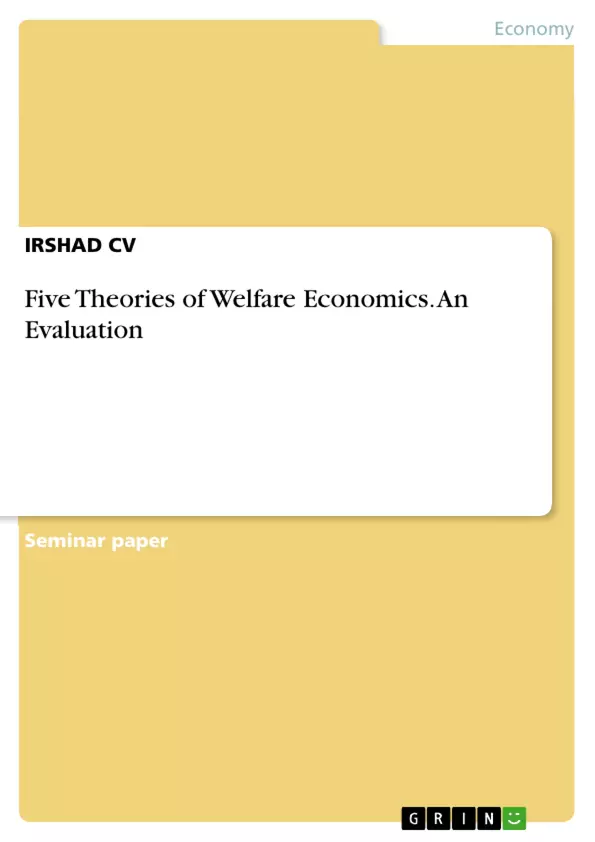This is a collective analysis of five major economic theories of welfare. Here each of the theories is explained separately in a brief manner. The diagrammatic representation is also used here to understand the concepts easily. Further an evaluation of each theory has also been provided along with the discussion. This note includes the following five welfare economic theories.
1) Pareto Optimality;
2) Kaldor-Hicks Compensation Criterion;
3) Social Welfare Function of Bergson and Samuelsson;
4) Scitovisky Criterion; and
5) Amartya Sen’s Theory of Welfare.
Table of Contents
- Preface
- Introduction
- Theories of Welfare Economics
- Pareto Optimality
- Kaldor-Hicks Compensation Criterion
- Scitovsky Double Criterion
- Social Welfare Function of Bergson and Samuelsson
- Amartya Sen's View on Social Welfare
- Concluding Remarks
Objectives and Key Themes
This work aims to provide a concise yet comprehensive analysis of five prominent theories in welfare economics. It explores the core tenets of each theory, compares and contrasts their approaches, and critically evaluates their strengths and limitations. The analysis is based on a detailed self-study and welcomes suggestions for improvement.
- Pareto Optimality and its limitations
- The Kaldor-Hicks Compensation Criterion and its applications
- Social Welfare Functions and interpersonal comparisons of utility
- The role of value judgments in welfare economics
- Amartya Sen's critique of existing welfare theories
Chapter Summaries
Introduction: This chapter introduces the fundamental concept of welfare economics, emphasizing the importance of cooperation, trust, and the maximization of social welfare. It highlights the subjective nature of welfare and the complex social, economic, political, and psychological issues it encompasses. The chapter establishes the context for the subsequent analysis of various welfare economic theories and positions welfare economics as an integral aspect of a democratic society focused on rational resource allocation and potentially wealth redistribution through taxation or legislation.
Theories of Welfare Economics: This chapter presents an overview of diverse perspectives within welfare economics, emphasizing the lack of a universally accepted method for measuring social welfare. It introduces two major schools of thought: the Paretian approach, which prioritizes improvements that benefit at least one individual without harming others, and the approach of Samuelsson and Bergson, which allows for interpersonal comparisons of utility through a "Social Welfare Function" and considers welfare improvements even if they come at the cost of some individuals. The chapter lays out the five specific welfare theories which are examined in more detail in subsequent chapters.
Pareto Optimality: This chapter delves into Pareto's influential theory, highlighting its significance as a necessary condition for social welfare but also its limitations. The discussion centers around the absence of value judgments, the impossibility of interpersonal utility comparisons, and the complexities that arise when some individuals benefit at the expense of others. The chapter uses a diagrammatic representation involving indifference curves to explain the theory's application and limitations. A critical evaluation section points out the theory's inability to address situations where welfare improvements for some individuals result in welfare declines for others, especially in scenarios involving wealth redistribution. It also notes the theory's failure to identify a maximum social welfare level and the critique by Amartya Sen regarding its potential to overlook extreme inequalities within society.
Keywords
Welfare economics, Pareto Optimality, Kaldor-Hicks Compensation Criterion, Social Welfare Function, Bergson-Samuelson, Scitovsky Double Criterion, Amartya Sen, interpersonal utility comparisons, value judgments, social welfare maximization, resource allocation, wealth redistribution.
FAQ: A Comprehensive Analysis of Welfare Economics Theories
What is the overall purpose of this document?
This document provides a concise yet comprehensive preview of a work analyzing five prominent theories in welfare economics. It includes a table of contents, objectives and key themes, chapter summaries, and keywords, offering a structured overview of the subject matter.
What are the key theories of welfare economics covered?
The document focuses on five main theories: Pareto Optimality, the Kaldor-Hicks Compensation Criterion, the Scitovsky Double Criterion, the Social Welfare Function of Bergson and Samuelsson, and Amartya Sen's perspective on social welfare. Each theory is explored, compared, and critically evaluated.
What are the main objectives and themes explored?
The analysis aims to understand the core tenets of each welfare economics theory, compare their approaches, and assess their strengths and weaknesses. Key themes include Pareto Optimality and its limitations, the application of the Kaldor-Hicks criterion, social welfare functions and interpersonal utility comparisons, the role of value judgments, and Sen's critique of existing theories.
What is the content of the "Introduction" chapter?
The introduction establishes the fundamental concept of welfare economics, stressing the importance of cooperation, trust, and maximizing social welfare. It highlights the subjective nature of welfare and its complex social, economic, political, and psychological dimensions. It frames the subsequent analysis and positions welfare economics within a democratic society context.
What does the chapter on "Theories of Welfare Economics" cover?
This chapter provides an overview of different perspectives in welfare economics, highlighting the lack of a universally accepted method for measuring social welfare. It introduces the Paretian approach and the approach of Samuelsson and Bergson, contrasting their methodologies and laying the groundwork for the detailed examination of the five specific theories in subsequent chapters.
What are the key points discussed in the chapter on "Pareto Optimality"?
This chapter delves into Pareto's theory, emphasizing its significance as a necessary condition for social welfare but also its limitations. It discusses the absence of value judgments, the impossibility of interpersonal utility comparisons, and challenges in situations where some benefit at the expense of others. Diagrammatic representation and critical evaluation of its shortcomings are included, noting its inability to handle welfare improvements that harm some individuals and its failure to identify a maximum social welfare level.
What keywords are associated with this analysis of welfare economics?
Key terms include welfare economics, Pareto Optimality, Kaldor-Hicks Compensation Criterion, Social Welfare Function, Bergson-Samuelson, Scitovsky Double Criterion, Amartya Sen, interpersonal utility comparisons, value judgments, social welfare maximization, resource allocation, and wealth redistribution.
- Quote paper
- IRSHAD CV (Author), 2016, Five Theories of Welfare Economics. An Evaluation, Munich, GRIN Verlag, https://www.grin.com/document/336546



